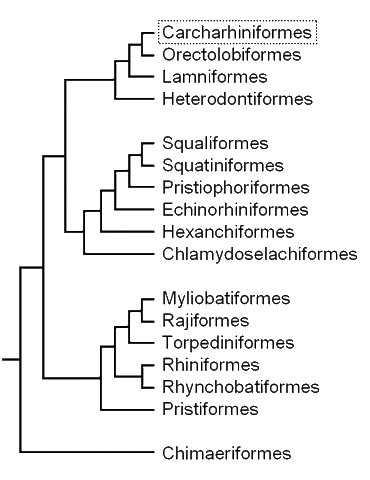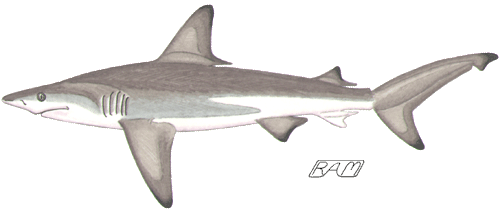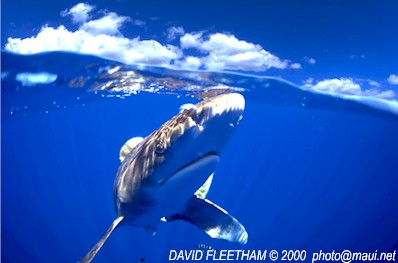Order Carcharhiniformes:
Ground or Whaler Sharks —
279+ species

- two dorsal fins (except in the scyliorhinid Pentanchus profundicolus, which has only one), without spines
- anal fin present
- five gill slits, with the last one to three over the pectoral fin base
- eyes with nictitating fold or membrane (moveable lower eyelid)
- intestinal valve of spiral or scroll type
- development highly variable - may be oviparous, ovoviviparous, or viviparous (the developing fetuses nourished via a yolk-sac placenta)
- found in virtually every marine habitat, many species occur in estuarine areas and a few make use of freshwater habitats as well; they range from coastal areas to the open ocean, in temperate to tropical zones of the Atlantic, Pacific, and Indian oceans
- at least 49 genera in 9 families (possibly as many as 60 genera in 14 families)
|
|
|

A representative carcharhinoid, the Blacktip Shark (Carcharhinus [Aprionodon] limbatus), showing the posterior gill slits over the pectoral fin base, two spineless dorsal fins, and presence of an anal fin characteristic of the group. Note also the inset of a Blacktip Shark's eye, showing the movable nictitating ('winking') eyelid, which serves to protect the eyes from physical damage (as when prey held in the jaws flails in a desperate, last-ditch attempt to escape); all carcharhinoids have a nictitating membrane or fold which is movable to a greater or lesser extent depending upon the family to which an individual belongs - whaler sharks and hammerheads (families Carcharhinidae and Sphynidae, respectively) have fully occlusible nictitating membranes, while smoothhounds, houndsharks and catsharks (Triakidae, Galeorhinidae and Scyliorhinidae, respectively) have partially to barely occlusible nictitating folds, causing the eyes to roll downward and appear to 'sink' into the head.
The carcharhinoids are a large and highly successful group of generalists, including many of the most familiar, dangerous, and economically important sharks.
Despite their remarkable range of sizes, habitats, and habits, the carcharhiniform sharks are structurally more uniform than most elasmobranch orders. The secret to the carcharhinoids' success seems to be that they are 'jacks of all trades', able to exploit a wide variety of prey and environments.
One of three species of open-ocean carcharhinoid, the Oceanic Whitetip (Carcharhinus longimanus) may use similarly sized and colored toothed whales as a kind of 'moving blind' — enabling them to launch ambush attacks on tunas, billfishes, and other speedy pelagic animals that it could probably never sneak up on in the featureless expanse of the open sea.'
Photo © David Fleetham david@davidfleetham.com; used with the gracious permission of the photographer.
The systematics of carcharhinoids is the most complex and contentious of all shark groups. Recent molecular systematic work has demonstrated that the family Triakidae as defined by Leonard Compagno (1988) is not monophyletic (forming a natural group derived from a single ancestor) and therefore requires splitting into two families, Triakidae and Galeorhinidae. Further, the genus Triakis is not monophyletic, requiring being split into two genera, Triakis and Cazon. Recent systematic work by Compagno (1988) and independent molecular genetics studies - using mtDNA sequences - by Gavin Naylor (1992) have indicated that the family Carcharhinidae does not form a monophyletic group unless the hammerheads (traditionally placed in the family Sphyrnidae) are included within that family. In addition, the 1992 study by Naylor strongly suggests that the genus Carcharhinus — as currently defined — is not a monophyletic group, and will almost certainly require splitting into several genera. Since the hammerheads form a distinct, monophyletic group, I prefer to regard them as a valid family. By placing the Tiger Shark and sharpnose sharks in their own families (Galeocerdidae and Rhizoprionodontidae, respectively) and redefining the family Carcharhinidae more restrictively than traditionally done, a classification that more accurately reflects the available phylogenetic data results. Only time and further research will tell whether the scheme proposed here accurately reflects the evolutionary history of carcharhinoid sharks.
Carcharhinidae and Galeocerdidae — Whaler and Tiger Sharks
Sphyrnidae — Hammerhead Sharks
Proscylliidae and Pseudotriakidae — Finback Catsharks and False Catsharks
![Underside of the head
of the Blacktip Shark
(Carcharhinus [Aprionodon] limbatus)](profile-images/carchar/a_limbatus_ush.gif)
![Upper and lower anterior
teeth of the Blacktip Shark
(Carcharhinus [Aprionodon] limbatus)](profile-images/carchar/a_limbatus_tth.gif)

